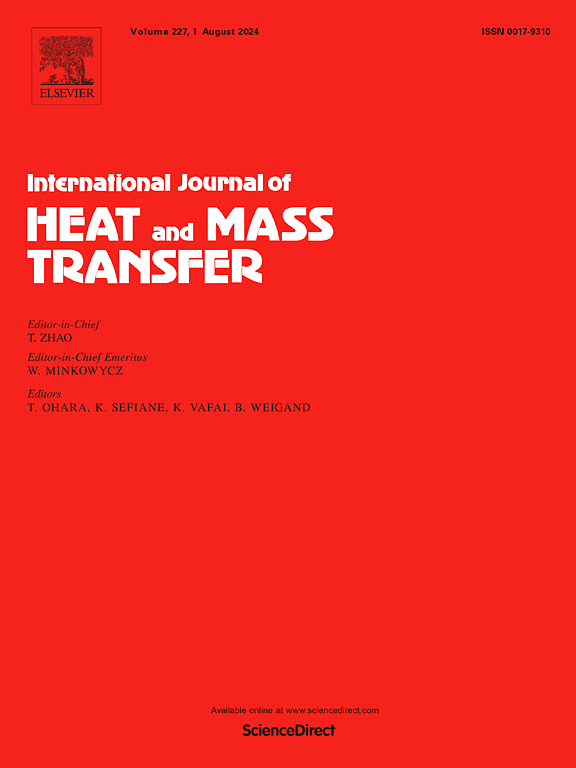垂直管中对流湍流混合对流传热的雷诺平均纳维-斯托克斯模拟
IF 5
2区 工程技术
Q1 ENGINEERING, MECHANICAL
International Journal of Heat and Mass Transfer
Pub Date : 2024-11-16
DOI:10.1016/j.ijheatmasstransfer.2024.126406
引用次数: 0
摘要
本研究对加热垂直圆管中的单相湍流对流混合对流进行了雷诺平均纳维-斯托克斯(RANS)模拟。以往的研究表明,Launder-Sharma k-ε 模型(以下简称 LS 模型)作为最常用的 RANS 湍流模型之一,有时会高估对流传热系数的实验数据。尽管 RANS 模型已广泛应用于各种工程问题中的对流,但 LS 模型出现异常的条件及其内在机制仍不清楚。本研究旨在了解各种混合对流条件下的模型特征及其适用性。本研究调查了 LS 模型、LS 模型与 Yap 修正以及 v2-f 模型,并将它们与现有的完全发达地区努塞尔特数和摩擦系数的实验数据进行了比较。在高浮力条件下,LS 模型对努塞尔特数和摩擦系数的预测明显偏高。当 NB,JF≈3×10-3 时,努塞尔特数的误差为 90%,其中 NB,JF 是表征浮力影响强度的控制参数。LS 模型预测失败的条件与加热壁附近发生反向流动的条件有关。我们得出反向流动条件下的 NB,JF≈1.25×10-3 。这种条件可用于 LS 模型无法应用的情况。带有 Yap 修正和 v2-f 模型的 LS 模型可以成功预测从强制对流到混合对流条件下 10-6<NB,JF<10-2 的实验数据。对于自然对流主导条件 NB,JF<10-2,带 Yap 修正的 LS 模型数值不稳定,无法获得收敛的数值解;而 v2-f 模型则稳定地再现了实验数据。通过优化 Yap 修正中的模型常数,可以提高高浮力对流条件下计算的稳定性和准确性。本文章由计算机程序翻译,如有差异,请以英文原文为准。
Reynolds-averaged Navier-Stokes simulations of opposing flow turbulent mixed convection heat transfer in a vertical tube
This study performed Reynolds-Averaged Navier-Stokes (RANS) simulations of a single-phase turbulent opposing flow mixed convection in a heated vertical circular tube. Previous research has reported that the Launder-Sharma model (hereafter the LS model), one of the most popular RANS turbulence models, sometimes overestimates experimental data of heat transfer coefficients for opposing flows. Although the RANS models have been widely applied to opposing flows in various engineering problems, the conditions under which the anomaly in the LS model occurs and the underlying mechanisms remain unclear. This study aimed to understand the model characteristics and their applicability under various mixed convection conditions. This study investigated the LS model, the LS model with the Yap correction, and the model, comparing them with existing experimental data of the Nusselt number and the friction coefficient in fully developed regions. The LS model remarkably over-predicted the Nusselt number and the friction coefficient under highly buoyant conditions. The error for the Nusselt number was >90 % for , where is a controlling parameter characterizing the strength of buoyancy influence. The conditions under which the prediction of the LS model failed were linked to those under which reverse flow occurred near the heated wall. We obtained for the reverse flow condition. This condition could be used where the LS model could not be applied. The LS model with Yap correction and model could predict experimental data successfully from forced convection to mixed convection conditions . For natural convection-dominant conditions , the LS model with the Yap correction was numerically unstable and could not obtain a converged numerical solution; however, the model stably reproduced the experimental data. By optimizing the model constants included in the Yap correction, the stability and accuracy of the calculations could be improved under highly buoyant opposing flow conditions.
求助全文
通过发布文献求助,成功后即可免费获取论文全文。
去求助
来源期刊
CiteScore
10.30
自引率
13.50%
发文量
1319
审稿时长
41 days
期刊介绍:
International Journal of Heat and Mass Transfer is the vehicle for the exchange of basic ideas in heat and mass transfer between research workers and engineers throughout the world. It focuses on both analytical and experimental research, with an emphasis on contributions which increase the basic understanding of transfer processes and their application to engineering problems.
Topics include:
-New methods of measuring and/or correlating transport-property data
-Energy engineering
-Environmental applications of heat and/or mass transfer

 求助内容:
求助内容: 应助结果提醒方式:
应助结果提醒方式:


